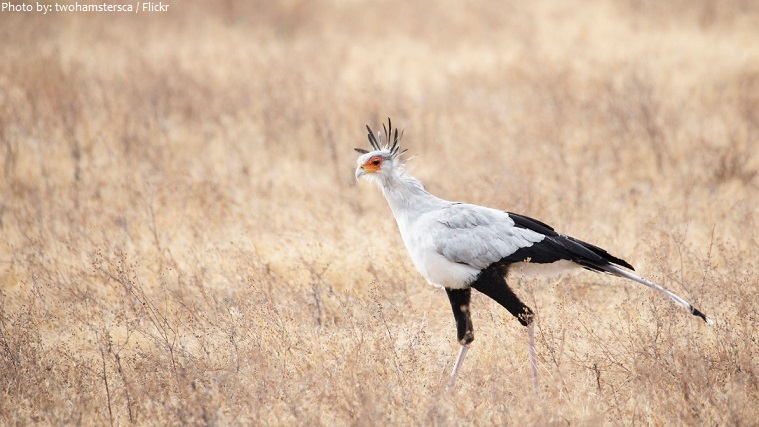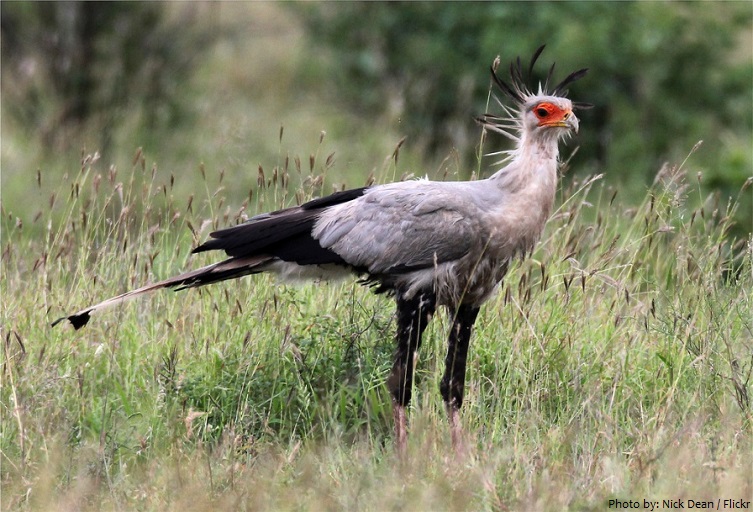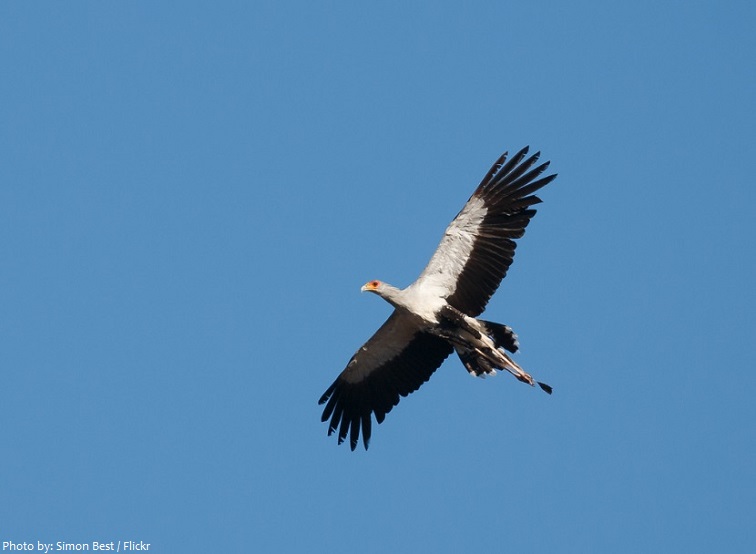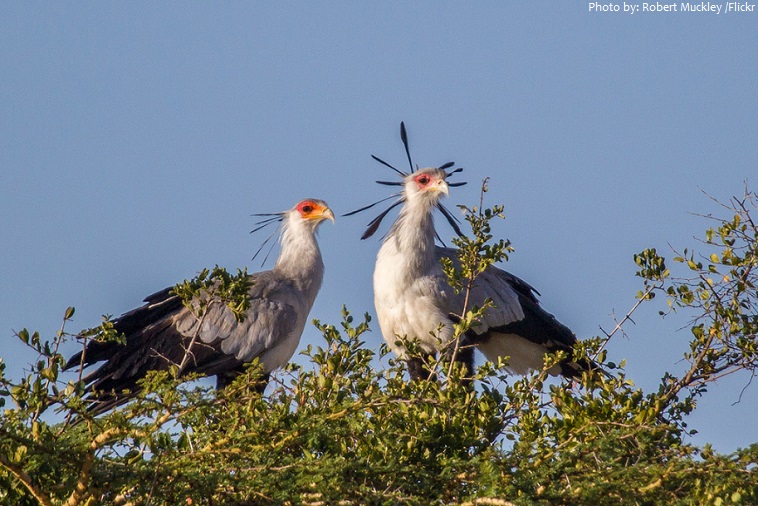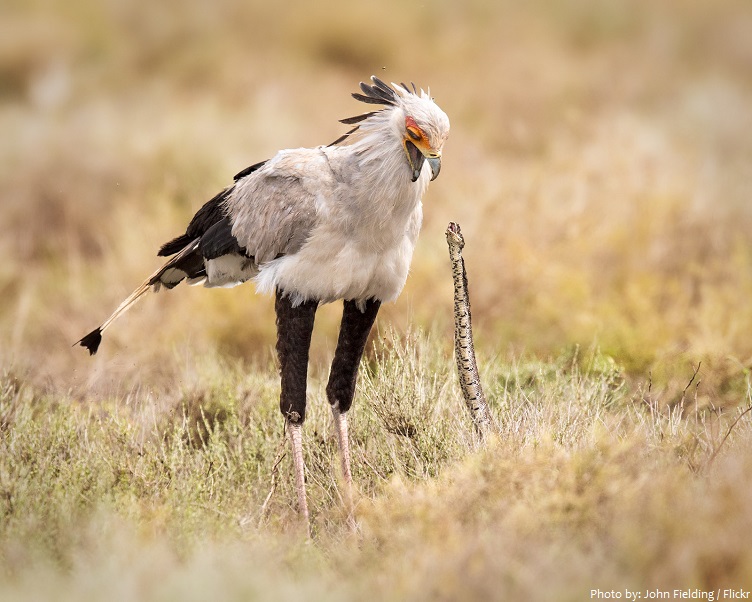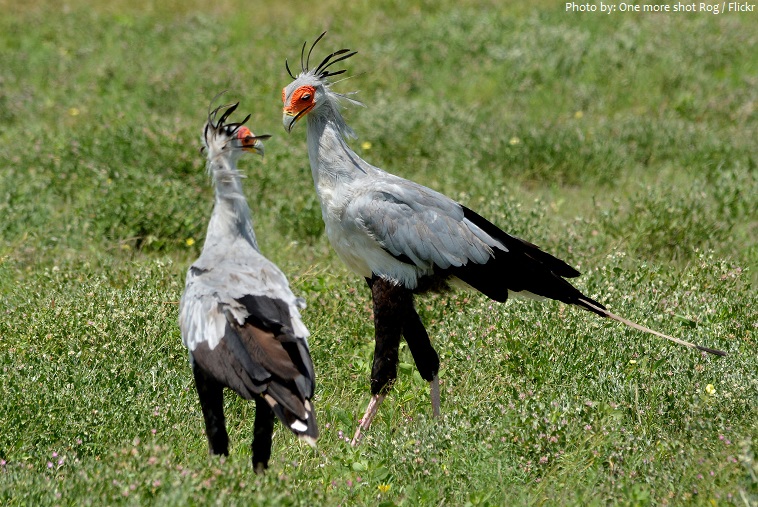The secretary bird (Sagittarius serpentarius) is a very large, mostly terrestrial bird of prey.
Secretary birds are found in Sub-Saharan Africa.
Secretary birds prefer open grasslands and savannas, although they also live in semi-deserts and lightly wooded or scrub areas.
These birds are found at a variety of elevations, from sea-level to around 3,000 meters (9,850 feet).
The lifespan is 10 to 15 years in the wild and up to 19 years in captivity.
Secretary birds stand from 90 to 137 cm (35 to 54 in) tall and weigh between 2.3 to 5 kg (5.1 to 11 lb). The wingspan is from 191 to 220 cm (75 to 87 in).
Females tend to be slightly smaller than males.
The secretary bird is instantly recognizable as a very large bird with an eagle-like body on crane-like legs.
This bird has an eagle-like head with a hooked bill, but has rounded wings.
The plumage is generally gray in color, perhaps with some white feathers. They have black flight feathers on the wings and a crest of black-tipped feathers on the back of the head. The bare face is orange to red in color.
The secretary bird has the longest legs of any bird of prey.
Secretary birds prefer to walk rather than fly, and average about 20 to 30 km (12 to 19 mi) a day on foot.
Secretary birds may spend most of their time on the ground, but they are good fliers. When they do fly, they fly well and often at great heights. In flight, their long legs trail behind them in the air.
From a distance or in flight it resembles a crane more than a bird of prey.
Secretary bird roost on the local Acacia trees at night. A few hours after dawn, secretary birds drop down to the ground from their nighttime roost to start the daily hunt.
The secretary bird is sometimes solitary, but is more often found in pairs or family groups consisting of up to five individuals.
Secretary birds are territorial and occupy areas up to 50 square kilometers (19 square miles).
Unlike most birds of prey, the secretary bird is largely terrestrial, hunting its prey on foot. Adults hunt in pairs and sometimes as loose familial flocks.
The birds will set out across a grassy area at a steady pace searching for movement. If a particularly thick tuft of grass is encountered, the bird will stamp on it to flush out any potential prey. Once prey is spotted, the bird quickens its pace to take the prey by surprise. If a chase commences, the bird will flap its wings and run after the prey until catching up to it.
Their diet consist of insects, mammals ranging in size from mice to hares and mongoose, crabs, scorpions, lizards, snakes (including several poisonous species), tortoises, young birds, bird eggs, and sometimes dead animals killed in grass or bush fires.
This birds are generally silent. When they do call, they typically give a deep, low croaking wail that can be heard for quite some distance.
Secretary birds are monogamous and are thought to pair for life. During courtship, they exhibit a nuptial display by soaring high with undulating flight patterns. A deep, low croak or a roaring groan can be made during a courtship flight. Males and females can also perform a grounded display by chasing each other with their wings up and back, much like the way they chase prey.
Nests are built at a height of 5–7 m (16–23 ft) on Acacia trees. Both the male and female visit the nest site for almost half a year before egg laying takes place. The nest is around 2.5 m (8 feet) wide and 30 cm (one foot) deep, and is constructed as a relatively flat basin of sticks.
The female lays a clutch of 1 to 3 eggs, with each egg laid two to three days apart. Incubation lasts between 42 to 46 days. Incubation duties are shared by both the male and female, although more frequently by the female. The male brings food to the nest for the female during this time.
The eggs hatch in the order they were laid, a few days apart. After the eggs hatch, parental care is constant. Both parents feed regurgitated and liquefied insects and small animals directly to the youngsters. Unlike other birds of prey, secretary bird parents often raise more than one chick successfully.
Adult secretary birds have no natural predators. Eggs and youngsters are preyed upon by crows, ravens, ground hornbills, kites and eagle owls.
Secretary birds are assessed as vulnerable by the IUCN due to a recent rapid decline across their entire range.
The origins of the secretary bird’s name are much debated. One theory is that the feathers jutting out behind the bird’s head reminded 19th-century Europeans of the quill pens that secretaries tucked behind their ears, while its grey and black body was reminiscent of their tailcoats. A more recent theory is that the name derives from the Arabic ‘saqr-et-tair’, or ‘hunter bird’.
The secretary bird’s taxonomic name, Sagittarius serpentarius, means “the archer of snakes.” The bird is famous for its snake-hunting abilities.
Perhaps the most beneficial action that the secretary bird performs for humans is eating rodent and insect pests that feed on the crops of the local peoples. Secretary birds also hunt the snakes that are attracted to the fields to eat the rodents.

